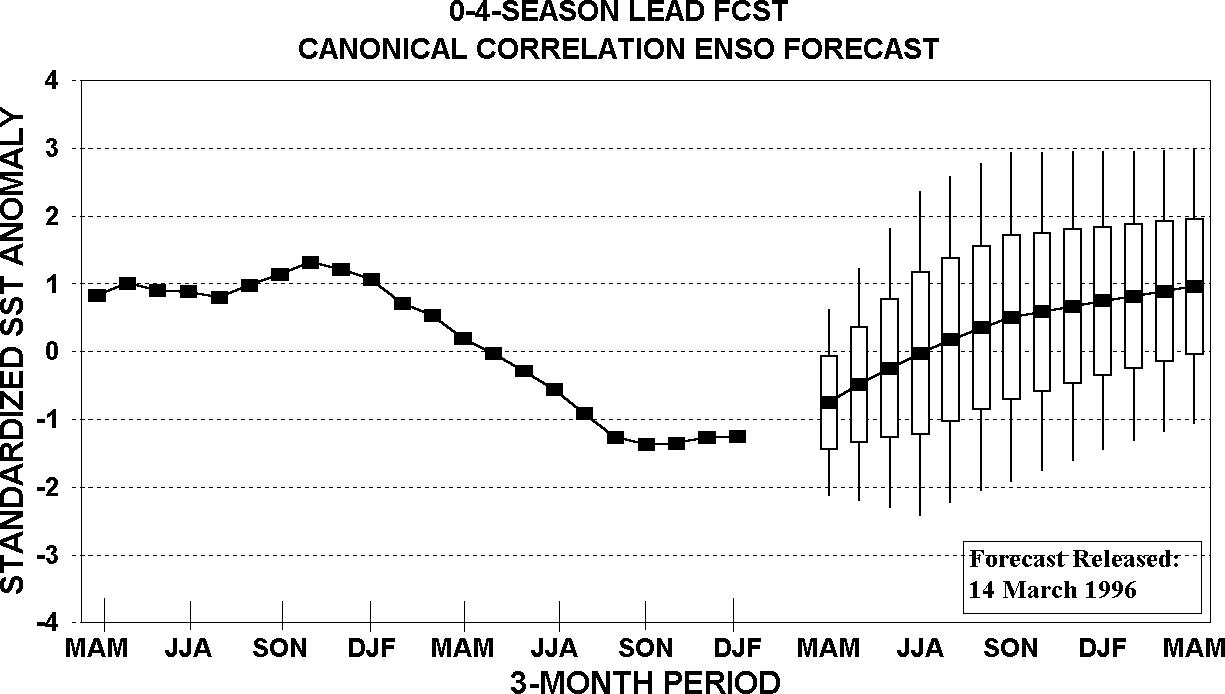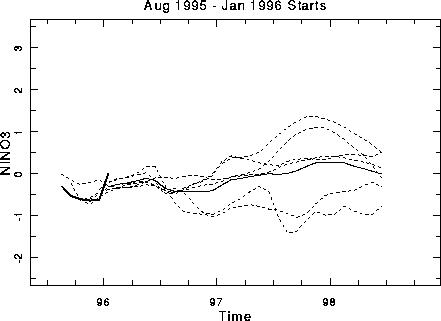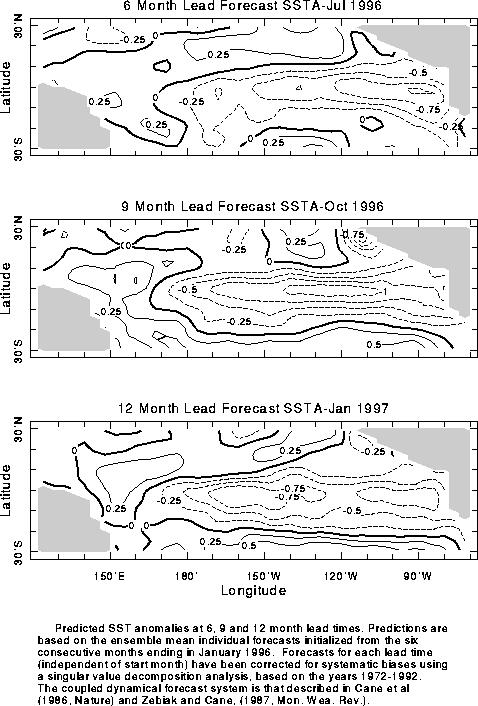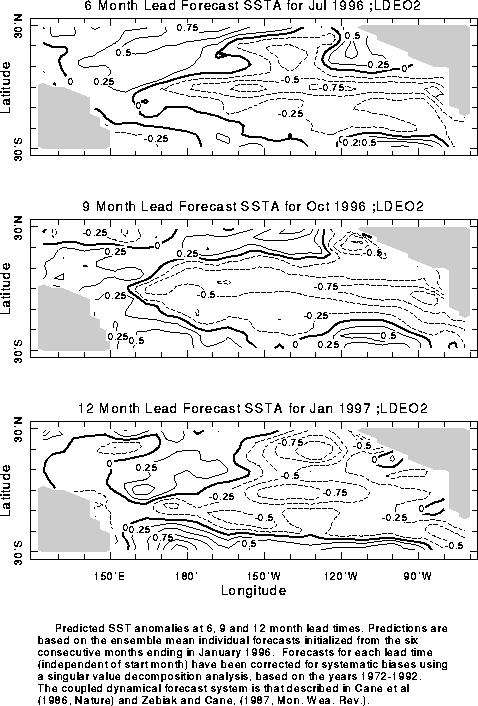[Next Article]
Forecasts of Tropical Pacific SST Using a Simple
Coupled Ocean-Atmosphere Dynamical Model
contributed by Stephen Zebiak and Mark Cane
Lamont-Doherty Earth Observatory, Columbia Univ., Palisades, New York
Since the middle to late 1980s, forecasts of the Nino 3 SST
anomaly have been regularly made at Lamont-Doherty Earth Observatory
of Columbia University using a simple coupled ocean-atmosphere
dynamical model (Cane et al. 1986, Cane and Zebiak 1987, Zebiak and
Cane 1987). This represented the beginning of a strong movement
toward physical approaches to the diagnosis and prediction of
climate and its short-term fluctuations. Here, we present a few
details of this model's current forecasts of Niño 3 and the
tropical Pacific basin. Forecasts using a new version of the model
with improved initialization are now additionally available; these
will be highlighted following a discussion of the forecasts of the
standard version of the model.
Figure 1 shows forecasts of the SST anomaly in Niño 3
for 3 to 15 months lead using data through January 1996, and the
observed Niño 3 SST over the past 2 years. These forecasts
are actually ensemble means of forecasts from six consecutive months
ranging from August 1995 to January 1996. Forecasts are adjusted to
have the same mean and standard deviation as the observed data for each
calendar month and lead time. The vertical bars show the error standard
deviations. These do not necessarily become larger with increasing lead
time, because even with an unchanging expected fraction of SST variance
explained by the forecasts, the natural interannual SST variability
changes with season. (The vertical axis is in anomalous C as opposed
to standardized anomaly in which case the size of the error bars would
reflect only the skill of the forecasts.) In this case the forecasts
describe a continuation of somewhat below normal Nino 3 conditions,
with strongest negative anomalies for winter 1996-97.
A closer look at the forecast integrations is
provided in Fig. 2, where six individual SST forecasts
beginning from 1-month-apart initial conditions from
August 1995 to January 1996 are shown along with the
ensemble mean which is used in Fig. 1. The forecasts
shown in Fig. 2 may not correspond exactly to those
shown in Fig. 1, because in Fig. 2 the forecasts are
adjusted to have the same mean and standard deviation
as observed data only on an overall basis rather than for
each calendar month and lead time. The spread among
the individual ensemble members is small from the
initialization times to boreal fall 1996, but becomes
large from that point onward.
Figure 3 shows 6, 9 and 12 month lead SST
anomaly forecasts for the tropical Pacific Basin,
verifying in July and October of 1996 and January of
1997, respectively. These forecasts are adjusted to have
the same mean and standard deviation as observed data
on an overall basis (not for each calendar month and
lead time), so they are exactly comparable with those
shown in Fig. 2 but not necessarily Fig. 1. Like those
for other target periods or for just Niño 3, the forecasts
are adjusted for systematic biases. One such bias is an
underestimation of amplitude of anomalies in the
central (but not eastern) Pacific, which causes anomaly
maxima to be placed too far east or prevents the central
Pacific from fully participating. A statistical correction
using singular value decomposition (SVD) is carried
out to do the adjustment. The 6, 9 and 12 month lead
forecast shown in Fig. 3 indicate a continuation of the
present cool conditions without abatement through
winter 1996-97.
Recent research at Lamont has shown that the skill
of the SST forecasts can be increased significantly by
improving the intialization system (Chen et al. 1995).
The existing system has used wind stress anomalies
(derived at Florida State University) to initialize the
forecast runs, without current analyzed SST data. A
newly developed system allows observed SST data to
participate in the intialization process. Skill is found to
increase not only in the early part of a forecast run but
at intermediate and long leads as well. The "spring
barrier" in skill that is present in the existing
initialization scheme is substantially reduced using the
improved system.
When the new initialization system is applied to
the current SST forecast, the result is as shown in Fig.
4. The improved scheme produces a forecast generally
similar to the customary Lamont forecast. This has not
always been the case, however; e.g. several months ago
the new scheme's forecast was for considerably colder
conditions than the old. Now, both schemes favor a cold
forecast.
References
Cane, M., S.E. Zebiak and S.C. Dolan, 1986: Experimental forecasts of El Nino. Nature, 321, 827-832.
Cane, M. and S.E. Zebiak, 1987: Prediction of El
Nino events using a physical model. In Atmospheric
and Oceanic Variability, H. Cattle, Ed., Royal
Meteorological Society Press, 153-182.
Chen, D., S.E. Zebiak, A.J. Busalacchi and M.A.
Cane, 1995:An improved procedure for El Nino
forecast-ing: Implications for predictability. Science,
269, 1699-1702.
Zebiak, S.E. and M.A. Cane, 1987: A model El
Nino-Southern Oscillation. Mon. Wea. Rev., 115, 2262-
2278.
Figures

Figure 1. Forecasts for the SST anomaly (oC) in the Ni¤o 3 region
(5oN-5oS, 90o-150oW), based on the simple coupled model of Cane and
Zebiak. Filled squares at the midpoints of the vertical forecast
boxes represent the predictions, and the vertical boxes (lines) show
the one (two) error standard deviations. The solid line represents the
observed three month mean SST anomaly in Ni¤o 3 up to the most recently
available data. The bars show forecasts for 1 month mean SST anomalies
at leads of 3, 6, 9, 12 and 15 months. See text for additional detail.

Figure 2. Time series of
forecasts of Ni¤o 3 SST from the Cane and Zebiak coupled model,
for individual 1-month-apart initial conditions from August 1995
to Janaury 1996 (dashed lines) and the ensemble mean (solid line)
used to form Fig. 1. However, an overall adjustment for the mean
and standard deviation is used rather than lead- and season-specific
adjustments as was done for Fig. 1. The thick solid line on left side
shows the observed one month mean SST over the temporal range of the
initial conditions.

Figure 3. Cane and Zebiak
coupled model SST anomaly forecast fields for July and October
1996, and January 1997, made at 6, 9 and 12 month lead times,
respectively. The forecasts are ensemble averages of 6 forecasts with
1-month-apart initial conditions ranging from August 1995 to January
1996. Adjustments for the mean and standard deviation are applied,
based on lead time but independent of start time.

Figure 4. As in Fig. 3 except
for the forecast made using the new initialization procedure (LDEO2)
(Chen et al. 1995).
[Purpose] -
[Contents] -
[Editorial Policy] -
[Next Article]



